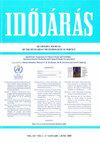利用大陆性、海洋性和干旱指数对塞尔维亚气候变化研究的贡献
IF 0.8
4区 地球科学
Q4 METEOROLOGY & ATMOSPHERIC SCIENCES
引用次数: 0
摘要
这项研究的目的是根据对四种气候指数的分析,介绍塞尔维亚共和国领土上的一些具体气候条件,这有助于了解当代气候变化。使用1951-2010年31个气象站的气温和降水资料。数据序列的相对均匀性采用MASH v3.02方法。使用的指数有:Johansson大陆指数、Kerner海洋性指数、De marton干旱指数和Pinna综合指数。利用QGIS软件包2.8.1对上述4个指标的数值分布进行地理空间分析。研究结果表明,大陆性效应存在于塞尔维亚的大部分地区,而海洋性在局部地区,主要是在该国的西部和西南部地区。进一步的分析表明,塞尔维亚不存在干燥和半干燥的地中海气候。考虑到一年中最温暖的时候(7 - 9月)是干燥的,此时对水的需求增加,沃尔特气候图清楚地表明了这一点,以及第二个30年期间(1981-2010)在植被期观察到温度升高和降水减少,可以得出结论,塞尔维亚有干旱气候的趋势。本文的研究结果可以帮助决策者规划一定的气候变化适应措施。本文章由计算机程序翻译,如有差异,请以英文原文为准。
Contribution to the study of climate change in Serbia using continentality, oceanity, and aridity indices
The aim of the study is to present some specific climatic conditions on the territory of the Republic of Serbia based on the analysis of four climate indices, which can help in understanding contemporary climate changes. Temperature and precipitation data from 31 meteorological stations for the period 1951–2010 were used. The relative homogeneity of the data series was done using the MASH v3.02 method. The indices used are: Johansson Continentality Index, Kerner Oceanity Index, De Martonne Aridity Index, and Pinna Combinative Index. Geospatial analysis of the distribution of the values of the four mentioned indices was done using the QGIS package 2.8.1. The results of the research show that the continentality effect is present in most of Serbia, while oceanity is observed locally, mainly in the western and southwestern parts of the country. The further analysis showed that there is no dry and semi–dry Mediterranean climate in Serbia. Considering that it is dry in the warmest part of the year (July–September), when the need for water is increased, which is clearly shown by the Walter climate diagram, as well as the fact that an increase in temperature and a decrease in precipitation during the vegetation period were observed in the second 30–year period (1981–2010), it can be concluded that in Serbia there is a tendency towards arid climate. The results presented in this paper can help decision makers to plan certain climate change adaptation measures.
求助全文
通过发布文献求助,成功后即可免费获取论文全文。
去求助
来源期刊

Idojaras
地学-气象与大气科学
CiteScore
1.60
自引率
11.10%
发文量
9
审稿时长
>12 weeks
期刊介绍:
Information not localized
 求助内容:
求助内容: 应助结果提醒方式:
应助结果提醒方式:


